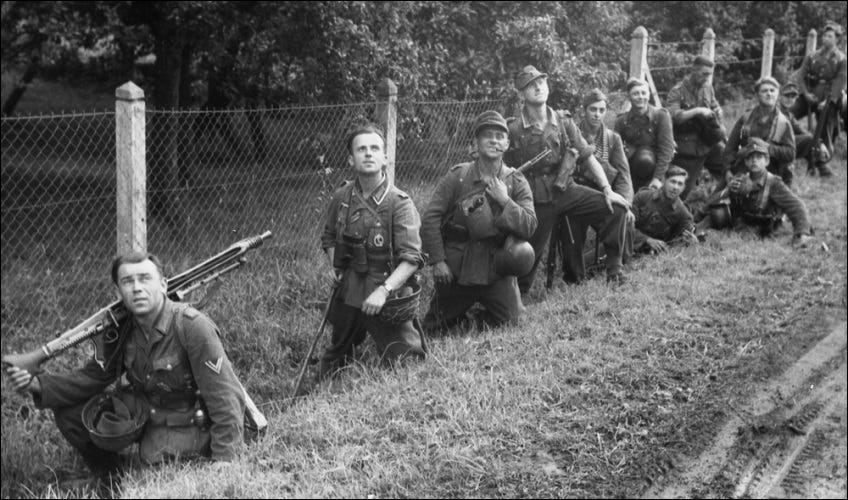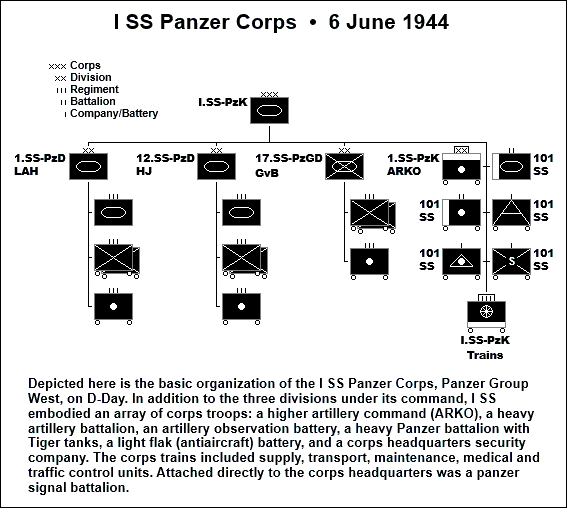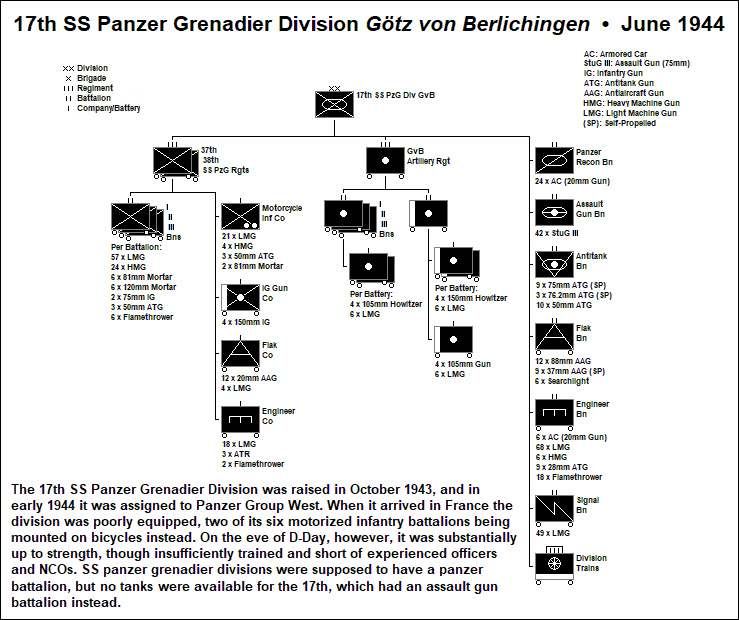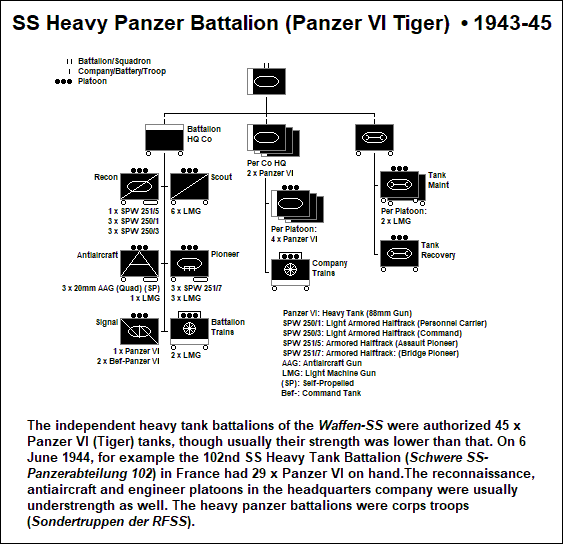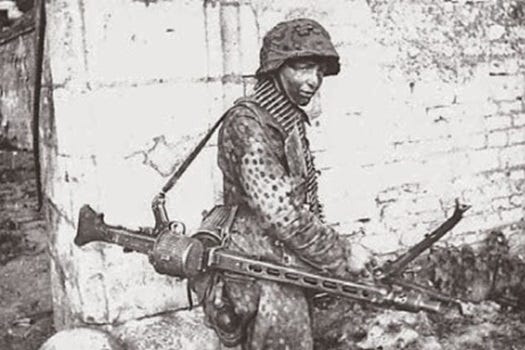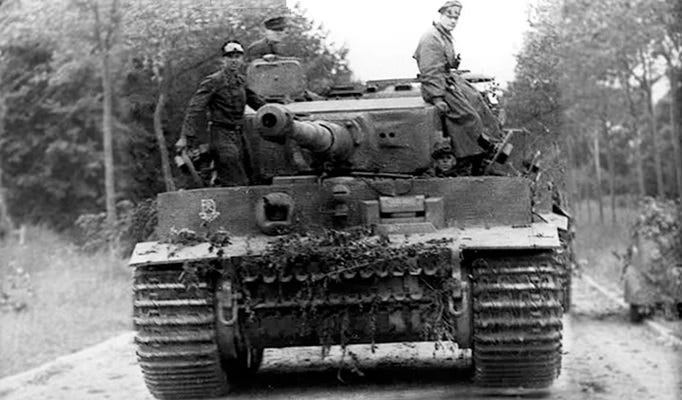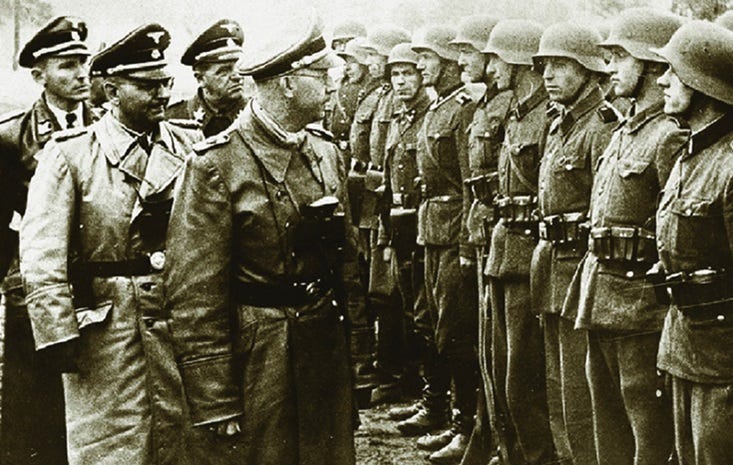
Note: For the organization of the German Army panzer divisions involved in the Battle of Normandy, see The German Order of Battle (Ground Forces):
By the spring of 1944 there were ten mechanized divisions (nine panzer, one panzer grenadier) in the OB West order of battle. These formations constituted the German Army’s trump card in the West, its best chance of defeating the Allied invasion of France, which was known to be imminent.
Four of these ten divisions were units of the Waffen-SS. Though this armed military branch of the Schutzstaffel was separate from the German Army, it served under Army operational control throughout the war. The armed SS got its start in 1933 when Sepp Detrich, Hitler’s former chauffeur and bodyguard who’d been made an SS officer, organized a small unit of about two hundred men to serve as the Führer's personal guard. It soon grew to the size of an infantry regiment and in 1934 was titled the Liebstandarte Adolf Hitler, later amended to Liebstandarte SS-Adolf Hitler. Standarte may be translated as regiment and Liebstandarte as bodyguard regiment.
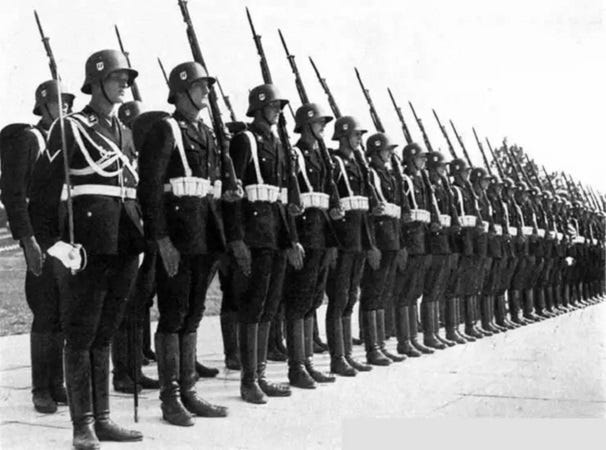
The establishment of the Liebstandarte as an SS organization was the first phase of a long-range plan. Hendrich Himmler, the Reichführer-SS (National SS Leader), aspired to build up an SS armed force, completely loyal to the National Socialist regime, which would rival and eventually replace the Army. To that end, personnel of the armed SS were carefully selected, underwent rigorous physical and military training, and were thoroughly indoctrinated in Nazi racial ideology. They were obliged to swear a personal oath of loyalty to Hitler, pledging "obedience unto death." The armed SS had its own unit designations and rank titles, similar to those of the SA (Stormtroopers), e.g. Standarte for regiment and Standartenführer for colonel. During the war, however, Army unit designations—battalion, regiment, etc.—were adopted to avoid confusion.
In 1937 an officer training school was opened: the SS-Junkerschule Bad Tölz. In line with Himmler's plan, the school's curriculum aimed at the production of politically and ideologically conscious officers, free of the conservative prejudices and outmoded habits of thought that Himmler believed to be characteristic of the Army officer corps. A second SS-Junkerschule was later established in the city of Braunschweig.
At the beginning of the war, the armed SS, at that time called the SS-Verfügungstruppen (SS Special Service Troops), was still a small organization, with sufficient combat units to form a single motorized infantry division. Thereafter, however, the armed SS expanded rapidly, and by early 1944 its order of battle listed over twenty divisions, twelve of which were mechanized (panzer and panzer grenadier). The SS-VT was officially redesignated as the Waffen-SS in July 1940.
The Waffen-SS mechanized divisions under the command of OB West in 1944 resembled their Army counterparts but were somewhat larger. Three of them formed I SS Panzer Corps under Panzer Group West. The other was stationed in southern France under Army Group G.
The authorized organization of a Waffen-SS panzer division is shown in the following diagram. As compared to its Army counterpart, it had various extras tucked away here and there, e.g. regimental motorcycle infantry and engineer companies, rocket artillery batteries, and a larger armored reconnaissance battalion. All three, 1. SS-Panzerdivision Leibstandarte SS Adolf Hitler, 2. SS-Panzerdivision Das Reich, and 12. SS-Panzerdivision Hitlerjugend were similarly organized, but there were equipment shortages in all three divisions. Liebstandarte, for instance, had only forty-two Panzer IV and thirty-eight Panzer V (Panther) medium tanks, as against the seventy-four of each that were authorized. Nor did any of the SS panzer divisions ever receive the heavy panzer company (Panzer VI Tiger tanks) that the table of organization specified.
Liebstandarte and units that later became part of Das Reich had fought in the 1940 French campaign, the Balkans and on the Eastern Front before being transferred to France, and were veteran, battle-tested formations. Hitlerjugend, however, was a new division. As its title indicates, it was founded on a small cadre of seasoned veterans and filled out with Hitler Youth members, many of the latter still in their teens, some as young as sixteen.
The 17. SS-Panzergrenadierdivision Götz von Berlichingen was the only unit of its type in France. The division was supposed to have a battalion of Panther medium tanks and one of its artillery battalions should have been self-propelled, but the necessary equipment was unavailable. There were no tanks at all, and the artillery was motor towed by trucks captured from the French Army. Nor were the division's troops of the same high quality as those of the older SS divisions. Most of its original cadre came from replacement units or were conscripts, including a large contingent of Volksdeutsch (ethnic Germans) from Romania. There were also a number of French volunteers.
After D-Day, II SS Panzer Corps with two Waffen-SS panzer divisions, 9. SS-Panzerdivision Hohenstaufen and 10. SS-Panzerdivision Frundsberg, arrived in Normandy and was immediately committed in the Caen sector.
The Waffen-SS also embodied nondivisional corps troop units, such as were designated Heerestruppen (General Headquarters Troops) by the Army. Units of this type included heavy artillery and rocket artillery battalions, flak (antiaircraft) battalions, heavy tank battalions, assault gun battalions, motorcycle infantry battalions, and engineer battalions. The corps used them to augment its subordinate divisions as necessary, e.g. by allotting extra artillery to divisions participating in an attack. The Waffen-SS designated them as Special Troops of the National SS Leader (Sondertruppen der Reichführer-SS).
During and after the war, the Waffen-SS acquired the reputation of an elite fighting force. But though not without a certain validity, this appellation must be qualified in three ways.
First, the overall combat record of the Waffen-SS exhibits no marked superiority over comparable formations of the German Army. Panzer-Division Großdeutschland, the Army counterpart of the Liebstandarte, was a similarly elite formation, and its performance in battle was better in many ways than its SS rival. The difference was leadership. Especially at higher levels of command, Waffen-SS officers were handicapped by their lack of a professional military education. There was no corps of trained staff officers to match that of the Army General Staff. In the early stages of the Battle of Normandy, Hitlerjugend’s performance was disappointing, thanks mainly to poor staff work.
Second, as the Waffen-SS grew, the overall quality of its formations deteriorated. The exacting standards laid down for the armed SS in its early days were perforce relaxed. Even the old elite divisions like Liebstandarte and Das Reich had to accept conscripts, Volksdeutsch and foreign volunteers. At the end of the war there were thirty-eight Waffen-SS divisions, whose personnel came from here, there, and everywhere: Scandinavia, the Netherlands, Belgium, Italy, Hungary, Latvia, Estonia, Ukraine, Bosnia, Rumania etc. Some of these divisions were actually the size of regiments or brigades, and their performance in battle ranged from good through mediocre to abysmal.
The most notorious unit of this polyglot order of battle was the 36. Waffen-Grenadier-Division der SS, also known as the Dirlewanger Brigade after its commander, SS-Oberführer Oskar Dirlewanger. It was formed with convicted criminals straight out of the German prison system; its commander was a violent psychotic, alcoholic and drug addict. On the Eastern Front, the Dirlewanger Brigade complied a frightful record of atrocities that shocked and disturbed even the SS leadership.
Mention of the Dirlewanger Brigade leads to the third caveat concerning the record of the Waffen-SS: its propensity for atrocities. Besides those committed against civilian populations, and they were many, there were numerous instances throughout the war when Waffen-SS troops massacred prisoners of war. This happened not only in Poland and the USSR, but also in the western theaters of war. During the Battle of Normandy Hitlerjugend troops shot many Canadian POWs out of hand. During the Battle of the Bulge, troops of the Liebstandare killed well over a hundred American POWs during their advance, most notoriously at Malmedy in Belgum, where eighty-four captured American soldiers were executed by machine gun fire.
No assessment of the performance of the Waffen-SS during the Second World War is complete without mention of the numerous war crimes committed by Hendrich Himmler’s soldiers. The Reichführer-SS wanted ruthless, ideologically indoctrinated, National Socialist warriors—and that’s what he got.



